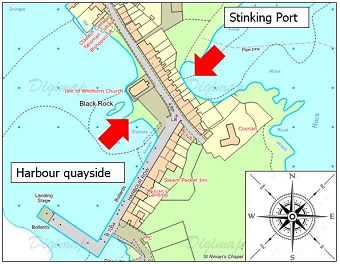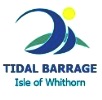BACKGROUND
The main objective of this project is to reduce the flood potential of the Isle of Whithorn. The flood potential of the village is the highest when combined effects – severe storms coming from the Southwest, low atmospheric pressure and high tide – take place at the same time. The harbour especially is affected by getting flooded from two sides: From the front side, facing the harbour quay and from the back, facing the Stinking Port – see figure below.
Therefore, we propose an integrated tidal barrage system to combine flood protection and power generation as well as an improvement of the retaining wall on land, facing the Stinking Port. Unlike conventional flood protection systems, which normally operate just in a few occasions during the year and therefore are highly cost-intensive due to operation and maintenance issues, our tidal barrage is a renewable and environmentally source of power production. This also includes collecting relevant data, such as tidal and bathymetry data, providing a design for the tidal barrage and retaining wall, researching turbine technologies and the grid infrastructure and assessing the overall costs of the project and impacts on the village.






